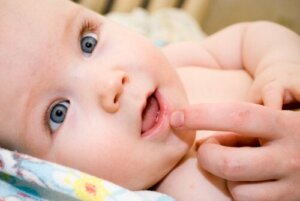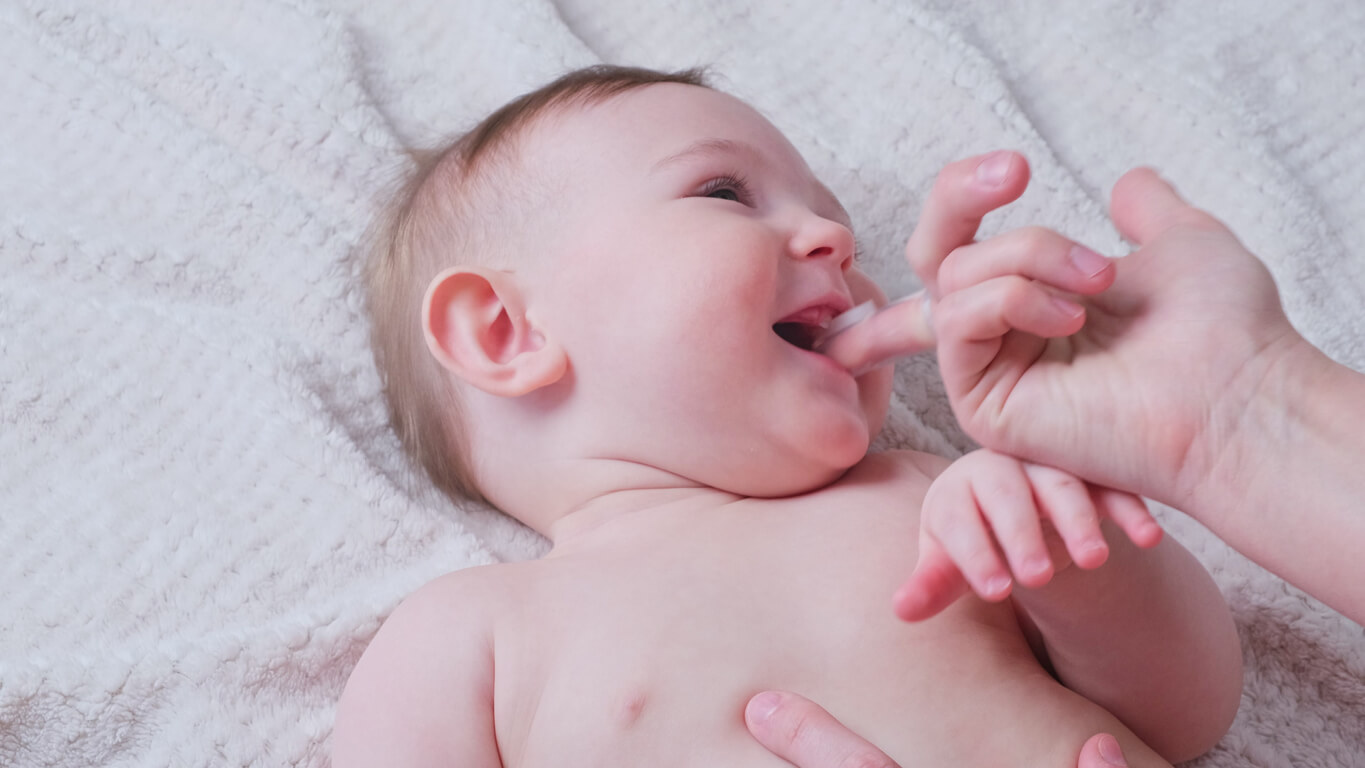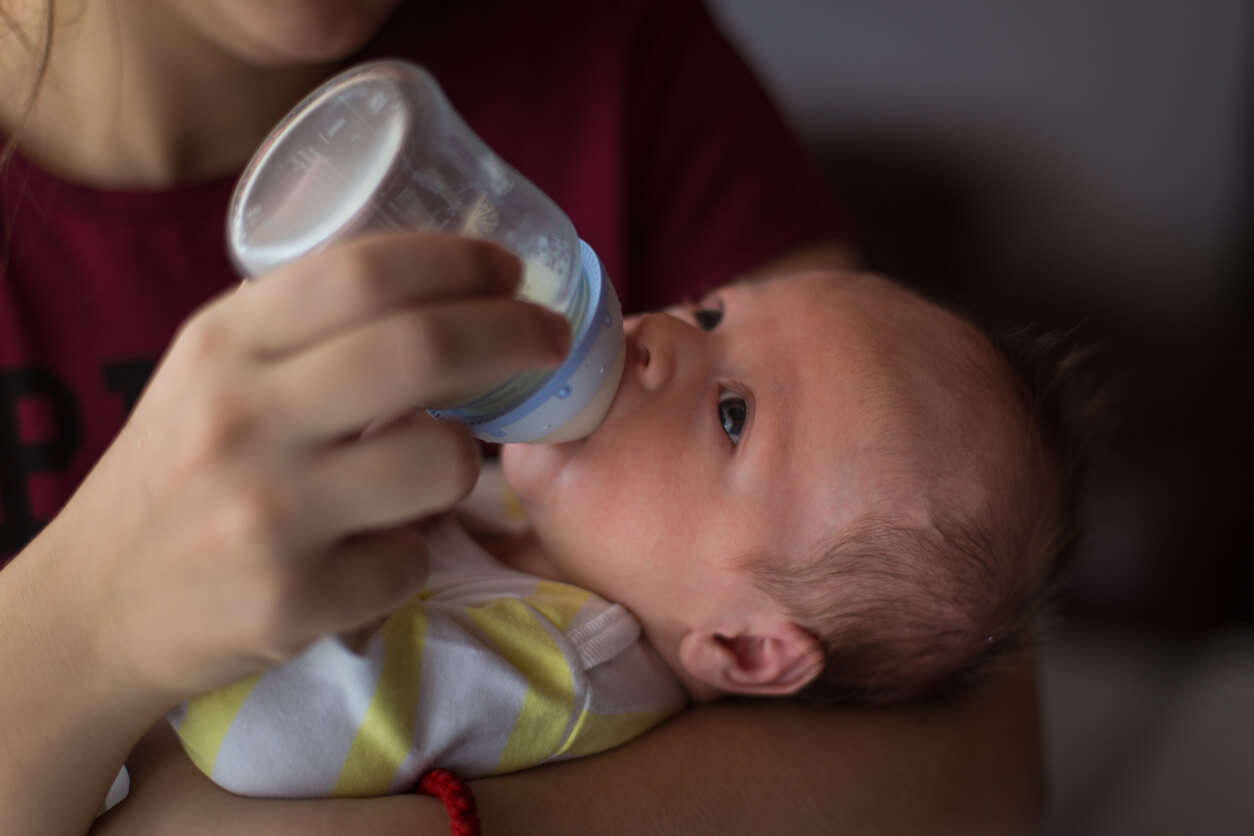8 Tips to Take Care of Your Baby's Mouth


Written and verified by the dentist Vanesa Evangelina Buffa
You don’t need to wait for the arrival of teeth to start taking care of your baby’s mouth. In this article, we’ll tell you how to be attentive to your baby’s oral needs from the first days of life.
The mouth allows the baby to experience changes and sensations that are necessary for its development. Through this part of his body, your little one relates to and gets to know the world they’ve arrived in. For example, breastfeeding, the eruption of teeth, the first meals, and babbling are natural processes in which the mouth participates. Therefore, it’s essential to keep it healthy so that it can fulfill its functions without problems.
Take note of these tips to take care of your baby’s mouth
Taking care of your baby’s mouth from an early age will help you prevent many complications. It’ll also favor the correct development of the structures that form it. Here are some tips to take care of your baby’s mouth and be attentive to the needs of this important part of their body.
1. Opt for breastfeeding
Breastfeeding brings multiple benefits. In addition to the nutritional quality, immune protection, and bonding between mother and child, breastfeeding also helps to take care of the baby’s mouth, as it facilitates the correct growth of the oral structures. This reduces the risk of bite problems in the future. In addition, the baby learns to perform the functions of sucking, swallowing, and breathing.
The nutrients provided by breastfeeding help the teeth forming inside the bone to develop. The calcium, phosphorus, and proteins provided by breast milk are necessary for the mineralization of the teeth. Combined with proper hygiene, breastfeeding reduces the risk of tooth decay and other conditions.
2. Clean the mouth before the teeth come in
Keeping your baby’s mouth clean is key to its care. The gums and tongue should be cleaned from the first months of life, even before the first tooth appears. In addition, with this practice, we help the child get used to oral hygiene as part of the daily routine. Also, with the massage that occurs during the cleaning of the gums, we can alleviate the discomfort that occurs when the teeth erupt.

3. Brush baby teeth as soon as they erupt
When the first tooth erupts, it’s time to start cleaning it with a toothbrush and toothpaste. Choose a small, soft-bristled instrument. The toothpaste should contain fluoride and a small smear that’s less than the size of a grain of rice should be used. When the child learns to spit, around 3 years of age, the dose increases to the size of a lentil.
Ideally, toothbrushing should be done twice a day or after every meal. At around 3 years of age, the child will have all of their 20 milk elements. Not taking care of children’s dental hygiene can cause cavities, gingivitis, bad breath, infections, and pain. With this, the child’s quality of life is affected.
Healthy baby teeth help with chewing, eating, speaking, and smiling without problems. In addition, it’ll allow the child to interact normally and not interrupt learning and play due to discomfort or pain. Also, temporary teeth help the permanent teeth to be positioned in place at the time of replacement. This reduces the risk of crooked teeth or bite problems in the future.
4. Avoid contagion
Childhood cavities are one of the most common diseases in children. It’s the destruction of the hard tissues of the teeth due to the action of acids produced by microorganisms fermenting sugars in the diet. Lack of oral hygiene and excessive consumption of sweets are factors that favor the appearance of the disease.
Transmission occurs, in general, from parents to their children. If adults have active cavities, badly destroyed teeth, or open and untreated molars, the risk of contagion is much higher. Everyday situations favor the transfer of bacteria:
- Blowing or tasting the baby’s food
- Sharing cutlery or utensils in the mouth
- Kissing the baby on the mouth
- Cleaning pacifiers, bottle nipples, or toys with your own saliva
- Using the same toothbrush
- Adults not taking care of their oral hygiene and having active cavities
5. Be careful with the use of the bottle
When breastfeeding isn’t possible, the bottle becomes essential for feeding the baby. But there are some considerations to be taken into account. For example, the choice is a very important aspect to consider.
- Choosing the right bottle: You should opt for one according to the child’s age and with a nipple with small holes that promote sucking effort.
- Protect against cavities: the use of a bottle with sugary liquids, such as formula milk, juices, and soft drinks, favors the appearance of cavities. The risk is greater if the child remains for a long time with the nipple in the mouth or falls asleep with the bottle.
- Remove the bottle in time: Its prolonged use can cause deformities in the oral structures and speech problems. Thus, before the age of 12 months, the child should stop using it.

6. Use the pacifier properly
Sometimes pacifiers bring benefits to the little one, but there are some aspects that should be taken care of so that it doesn’t have negative effects on the mouth. This accessory can bring comfort and tranquility and help the baby to fall asleep. It also helps to reduce the risk of sudden infant death syndrome.
It’s recommended to choose orthodontic models that most closely resemble the mother’s nipple and don’t deform the oral structures. At the same time, practices that favor the appearance of cavities, such as dipping them in sugar, honey, or sugary liquids, should also be avoided. As with the bottle, it should be removed in time (at 2 years of age) so that its use isn’t prolonged and doesn’t cause problems.
7. Take care of the diet
The incorporation of new foods is an important moment in the life of babies. To take care of your baby’s mouth, you need to be responsible with the foods and drinks that you offer them:
- Ensure a varied, balanced, and healthy diet: With this, we make sure that they get all the nutrients they need to grow. Among them, are calcium, phosphorus, and vitamins.
- Avoid sweet substances: Adding sugar to food, giving sweets, sugary drinks, juices, soft drinks, ultra-processed foods, and pastries from an early age increases the risk of mouth diseases, obesity, and diabetes.
- Take into account the consistency of the food: At the beginning of complementary feeding, you can opt for purees and soft textures, but little by little, harder foods should be incorporated. Giving the child pieces of food helps them learn to chew. This strengthens and exercises the orofacial structures.
8. Visit the pediatric dentist
Visiting a pediatric dentist before your baby’s first birthday is another way to take care of your baby’s mouth. After that, you should continue with regular checkups every six months.
Start taking care of your baby’s mouth today
Taking care of your baby’s mouth from an early age will bring many benefits. By putting into practice the tips we’ve shared above, you‘ll be able to take care of your baby’s health and well-being.
You don’t need to wait for the arrival of teeth to start taking care of your baby’s mouth. In this article, we’ll tell you how to be attentive to your baby’s oral needs from the first days of life.
The mouth allows the baby to experience changes and sensations that are necessary for its development. Through this part of his body, your little one relates to and gets to know the world they’ve arrived in. For example, breastfeeding, the eruption of teeth, the first meals, and babbling are natural processes in which the mouth participates. Therefore, it’s essential to keep it healthy so that it can fulfill its functions without problems.
Take note of these tips to take care of your baby’s mouth
Taking care of your baby’s mouth from an early age will help you prevent many complications. It’ll also favor the correct development of the structures that form it. Here are some tips to take care of your baby’s mouth and be attentive to the needs of this important part of their body.
1. Opt for breastfeeding
Breastfeeding brings multiple benefits. In addition to the nutritional quality, immune protection, and bonding between mother and child, breastfeeding also helps to take care of the baby’s mouth, as it facilitates the correct growth of the oral structures. This reduces the risk of bite problems in the future. In addition, the baby learns to perform the functions of sucking, swallowing, and breathing.
The nutrients provided by breastfeeding help the teeth forming inside the bone to develop. The calcium, phosphorus, and proteins provided by breast milk are necessary for the mineralization of the teeth. Combined with proper hygiene, breastfeeding reduces the risk of tooth decay and other conditions.
2. Clean the mouth before the teeth come in
Keeping your baby’s mouth clean is key to its care. The gums and tongue should be cleaned from the first months of life, even before the first tooth appears. In addition, with this practice, we help the child get used to oral hygiene as part of the daily routine. Also, with the massage that occurs during the cleaning of the gums, we can alleviate the discomfort that occurs when the teeth erupt.

3. Brush baby teeth as soon as they erupt
When the first tooth erupts, it’s time to start cleaning it with a toothbrush and toothpaste. Choose a small, soft-bristled instrument. The toothpaste should contain fluoride and a small smear that’s less than the size of a grain of rice should be used. When the child learns to spit, around 3 years of age, the dose increases to the size of a lentil.
Ideally, toothbrushing should be done twice a day or after every meal. At around 3 years of age, the child will have all of their 20 milk elements. Not taking care of children’s dental hygiene can cause cavities, gingivitis, bad breath, infections, and pain. With this, the child’s quality of life is affected.
Healthy baby teeth help with chewing, eating, speaking, and smiling without problems. In addition, it’ll allow the child to interact normally and not interrupt learning and play due to discomfort or pain. Also, temporary teeth help the permanent teeth to be positioned in place at the time of replacement. This reduces the risk of crooked teeth or bite problems in the future.
4. Avoid contagion
Childhood cavities are one of the most common diseases in children. It’s the destruction of the hard tissues of the teeth due to the action of acids produced by microorganisms fermenting sugars in the diet. Lack of oral hygiene and excessive consumption of sweets are factors that favor the appearance of the disease.
Transmission occurs, in general, from parents to their children. If adults have active cavities, badly destroyed teeth, or open and untreated molars, the risk of contagion is much higher. Everyday situations favor the transfer of bacteria:
- Blowing or tasting the baby’s food
- Sharing cutlery or utensils in the mouth
- Kissing the baby on the mouth
- Cleaning pacifiers, bottle nipples, or toys with your own saliva
- Using the same toothbrush
- Adults not taking care of their oral hygiene and having active cavities
5. Be careful with the use of the bottle
When breastfeeding isn’t possible, the bottle becomes essential for feeding the baby. But there are some considerations to be taken into account. For example, the choice is a very important aspect to consider.
- Choosing the right bottle: You should opt for one according to the child’s age and with a nipple with small holes that promote sucking effort.
- Protect against cavities: the use of a bottle with sugary liquids, such as formula milk, juices, and soft drinks, favors the appearance of cavities. The risk is greater if the child remains for a long time with the nipple in the mouth or falls asleep with the bottle.
- Remove the bottle in time: Its prolonged use can cause deformities in the oral structures and speech problems. Thus, before the age of 12 months, the child should stop using it.

6. Use the pacifier properly
Sometimes pacifiers bring benefits to the little one, but there are some aspects that should be taken care of so that it doesn’t have negative effects on the mouth. This accessory can bring comfort and tranquility and help the baby to fall asleep. It also helps to reduce the risk of sudden infant death syndrome.
It’s recommended to choose orthodontic models that most closely resemble the mother’s nipple and don’t deform the oral structures. At the same time, practices that favor the appearance of cavities, such as dipping them in sugar, honey, or sugary liquids, should also be avoided. As with the bottle, it should be removed in time (at 2 years of age) so that its use isn’t prolonged and doesn’t cause problems.
7. Take care of the diet
The incorporation of new foods is an important moment in the life of babies. To take care of your baby’s mouth, you need to be responsible with the foods and drinks that you offer them:
- Ensure a varied, balanced, and healthy diet: With this, we make sure that they get all the nutrients they need to grow. Among them, are calcium, phosphorus, and vitamins.
- Avoid sweet substances: Adding sugar to food, giving sweets, sugary drinks, juices, soft drinks, ultra-processed foods, and pastries from an early age increases the risk of mouth diseases, obesity, and diabetes.
- Take into account the consistency of the food: At the beginning of complementary feeding, you can opt for purees and soft textures, but little by little, harder foods should be incorporated. Giving the child pieces of food helps them learn to chew. This strengthens and exercises the orofacial structures.
8. Visit the pediatric dentist
Visiting a pediatric dentist before your baby’s first birthday is another way to take care of your baby’s mouth. After that, you should continue with regular checkups every six months.
Start taking care of your baby’s mouth today
Taking care of your baby’s mouth from an early age will bring many benefits. By putting into practice the tips we’ve shared above, you‘ll be able to take care of your baby’s health and well-being.
All cited sources were thoroughly reviewed by our team to ensure their quality, reliability, currency, and validity. The bibliography of this article was considered reliable and of academic or scientific accuracy.
- Blázquez, M. J. (2000). Ventajas de la lactancia materna. Medicina naturista, (1), 44-51.
- Monet Álvarez, D. E., Álvarez Cortés, J. T., & Gross Ochoa, V. Y. (2022). Beneficios inmunológicos de la lactancia materna. Revista Cubana de Pediatría, 94(3).
- Meza-Salcedo, R., & Pérez-Valverde, A. (2021). Beneficios de la lactancia materna. Odontología sanmarquina, 24(3), 311-312.
- Moya, M. P. (2015). Lactancia materna y su contribución al adecuado desarrollo del sistema estomatognático y sus funciones. REVISTA CIENTÍFICA SIGNOS FÓNICOS, 1(2).
- Robles-Bermeo, N. L., Lara-Carrillo, E., Herrera-Martínez, E., Bermeo-Escalona, J. R., Santillán-Reyes, A. M., Pontigo-Loyola, A. P., & Medina-Solís, C. E. (2019). Leche humana y su efecto sobre la mineralización del esmalte: revisión de literatura. Pediatría (Asunción), 46(3), 209-217.
- Hernández Bárcenas, K. A., Marulanda Rivera, J. A., Carrillo Estrada, G. Á., & Suárez Castillo, Á. Prácticas de higiene oral en niños de 0 a 36 meses de edad.
- Centeno, J. E. O. Cuidados de la salud bucodental en él bebe.
- Morales Miranda, L., & Gómez Gonzáles, W. (2019). Caries dental y sus consecuencias clínicas relacionadas al impacto en la calidad de vida de preescolares de una escuela estatal. Revista Estomatológica Herediana, 29(1), 17-29.
- Romero-González, M. A. (2019). Azúcar y caries dental. Revista Odontología Pediátrica, 18(1), 4-11.
- Diaz, C. E., Zeas, M. V., Bueno, A. C., Maldonado, E. B., Moya, J. E., Peña, E. V., … & Serrano, S. P. (2019). Síndrome de muerte súbita del lactante: una revisión narrativa. Archivos Venezolanos de Farmacologia y Terapéutica, 38(3), 340-346.
- Brunner-López, O., Fuentes-Martín, M. J., Ortigosa-Pezonaga, B., & López-García, A. M. (2019). Texturas evolutivas en la introducción de nuevos alimentos: un acercamiento teórico. Revista Española de Nutrición Humana y Dietética, 23(2), 104-122.
This text is provided for informational purposes only and does not replace consultation with a professional. If in doubt, consult your specialist.








